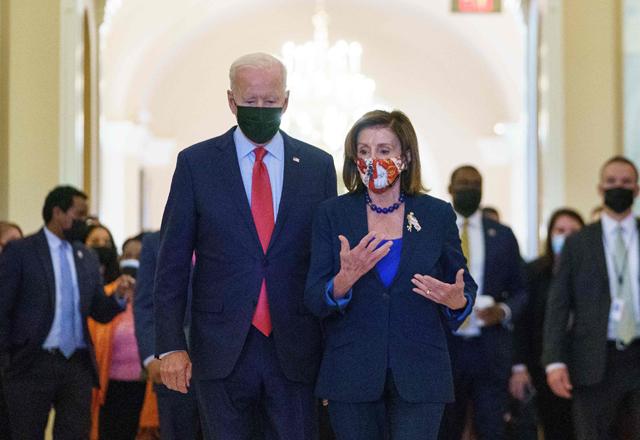You are here
US Congress back for frantic autumn with Biden agenda at stake
By AFP - Sep 19,2021 - Last updated at Sep 19,2021

In this file photo the dome of the US Capitol is seen on August 23. US lawmakers will dive into the busiest legislative period in years in the coming week, with President Joe Biden counting on a united front from Democrats to pass make-or-break spending bills that he hopes will improve his sagging approval ratings (AFP photo)
WASHINGTON — US lawmakers will dive into the busiest legislative period in years in the coming week, with President Joe Biden counting on a united front from Democrats to pass make-or-break spending bills that he hopes will improve his sagging approval ratings.
Facing stinging criticism over the chaotic US withdrawal from Afghanistan and a stubbornly elevated pandemic death toll, Biden is banking on going into next year’s midterm elections with historic economic reforms under his belt.
Avoiding a government shutdown is also at the top of the agenda, alongside dodging a catastrophic credit default, which may be the largest of the looming deadlines.
Build back better
Democrats are hoping to secure a sweeping $3.5 trillion social policy package through a process known as reconciliation, meaning the bill can pass with a simple majority in the evenly divided 100-member Senate.
Without reconciliation, 60 votes would be needed in a procedural vote just to advance the legislation, which would require support from 10 Republicans.
The so-called “Build Back Better” package aims to tackle climate change, lower child care and education costs for working families, and create millions of jobs.
Biden said in a speech on Thursday he was confident Congress would pass the plan, characterising it as a moment that could “change the trajectory of our country for years or decades to come”.
Republicans are unsurprisingly dismissing the proposals as an example of out-of-control tax-and-spend politics, but the real battle is playing out between moderate and progressive Democrats.
Worried about inflation and the national debt — $28.8 trillion and rising — centrist Democratic senators Joe Manchin and Kyrsten Sinema oppose the high ticket price, although Manchin has indicated he may be open to a $1.5 trillion package.
“We don’t have the need to rush into this and get it done within one week because there’s some deadline we’re meeting or someone’s going to fall through the cracks,” Manchin, who represents West Virginia, told NBC.
Senate budget chairman Bernie Sanders, backed by Majority Leader Chuck Schumer, has drawn his own red line, telling CNN that any bill that falls below the $3.5 trillion total is “absolutely not acceptable to me”.
Rebuffing misgivings about rising debt, House Democrats have circulated a plan to pay for Build Back Better through nearly $3 trillion in new taxes, mainly from wealthy Americans and corporations, on top of smaller reforms such as tougher tax enforcement.
Infrastructure
A $1.2 trillion infrastructure bill passed the Senate in August with the support of one-third of the 50 Republicans in addition to all 50 Democrats.
Democratic Speaker Nancy Pelosi promised a vote by September 27 in the House of Representatives, where her party holds a razor-thin majority.
But here too, the real fight is internal, with Democratic progressives saying they won’t vote for it until the larger reconciliation package is squared away.
Moderates won’t vote for reconciliation without infrastructure, which they say would be an easy win demonstrating Biden’s self-professed talent in bringing all sides together.
It is not clear how the debate will play out, but Hill watchers warn the process could take weeks or even months to complete.
The infrastructure bill includes $500 billion in new federal spending on roads, bridges, transportation, high-speed internet and climate change measures including a network of charging stations for electric cars.
Debt ceiling
and shutdown
The US debt ceiling must be suspended or raised soon in the coming weeks to avoid a default, which would trigger economic collapse and a worldwide financial meltdown.
Treasury Secretary Janet Yellen has warned of “irreparable damage to the US economy” as soon as next month.
Democrats usually join with Republicans to suspend the debt limit and did so most recently in August 2019, under Donald Trump’s administration.
Lawmakers will have to approve a new budget before October 1 to avoid a government shutdown — when financing for federal agencies dries up and they can no longer function.
Democrats are also looking at attaching disaster aid for wildfires and floods to any legislation aimed at averting the shutdown, creating an incentive for lawmakers in disaster-hit Republican states to play ball.
But Republicans are threatening to withhold their votes on any debt ceiling package.
They argue that Schumer, Pelosi and the White House should have addressed the debt limit in the Build Back Better package, because it doesn’t require Republican support.
Republicans have suggested that Biden’s policies have created the need for the debt limit increase.
An analysis of Treasury Department data shows however that Republicans accrued $7.8 trillion in new debt during the Trump administration — more than a quarter of the total — in just four years.
The country has added a fraction of that — around $600 billion — since Biden’s inauguration on January 20.
Related Articles
WASHINGTON — President Joe Biden vowed on Friday to get his sweeping domestic agenda over the line as he visited the US Congress to energise
WASHINGTON — The US Senate on Saturday voted to approve a $1.9 trillion relief package that President Joe Biden vows will revive the country
WASHINGTON — US President Joe Biden on Saturday signed into law a long-awaited funding bill passed by Congress, keeping federal agencies run


















